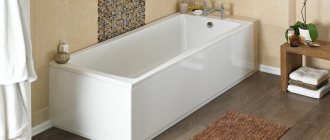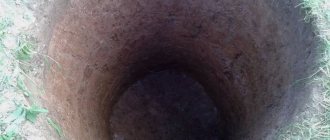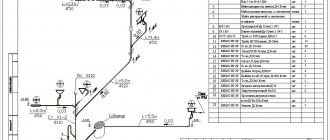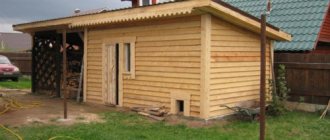A toilet on the site is the minimum living conditions in a country house or country house. When installing such a structure, the main difficulties arise with the cesspool. It accumulates waste that must be removed during operation.
But even if cleaning is carried out in a timely manner, during the heat the closet will emit unpleasant odors.
All this greatly overshadows the stay on the site. A practical solution could be a country toilet with an odorless pit cesspool. Our review will help you better understand all the design features, choose the right place for installation and choose the optimal toilet model.
Requirements for a toilet pit in the country
Before arranging a toilet, it is worth considering how often it will be used and by how many people. If the dacha is visited only in the summer, and the toilet will be used by 1-2 people, then a simple and small reservoir for draining feces will do. If the visit is intensive and regular, then you need to take care of a larger volume, tightness and the ability to clean the tank. If in the spring the groundwater at the dacha rises above 2.5 m, then it is impossible to equip a cesspool.
Important! In a country house with an extremely high level of wastewater, it is better to install a dry closet due to the likelihood of faeces being washed out.
If there is a well or a well at the dacha, then the toilet must be located definitely below the water. If the street cesspool overflows, the waste will not clog the drinking and technical source.
The bottom of the cesspool can be completely sealed or based on the filter principle using only a drainage pad made of sand and crushed stone. In the case of an insulated septic tank, faeces will need to be removed periodically using a suitable method. With a filter bottom, it is believed that the liquid part of the waste, undergoing some purification by drainage, will be absorbed into the soil. With this method, there is a high probability that the bottom of the cesspool will silt, which will prevent liquid from seeping into the soil.
Alternative option
If your groundwater is very high or you will use the structure occasionally, then you can make a country toilet without a cesspool, which is otherwise called a powder closet.
The simplest version of a powder closet
Its main feature is that a container is installed under the wooden toilet seat, most often a bucket, which serves to collect waste. The system is operated using filler, most often peat or fine sawdust is used for this.
The design is used as follows: filler is poured onto the bottom of the container, and filler is added after each use. Once the container is full, it should be taken out to the compost heap. As you can see, everything is very simple.
In order to minimize the unpleasant odor when using a powder closet, ventilation should be made in the form of a pipe coming from the compartment with the container upwards.
Ventilation is a very effective solution to combat unpleasant odors
Choosing a place for a pit for a toilet in the country
To make a cesspool toilet in the country, you need to choose the optimal location on your personal plot.
Basic sanitary standards that regulate the location of the cesspool of an outdoor toilet in a country house:
- The pit should be at least 12 m from a residential building.
- The toilet pit should be 4 m away from trees and 2 m away from bushes.
- The distance from the pit to the fence is at least 1 m.
- The pit is located more than 30 m from any source of water. The construction of a pit without a bottom near water bodies is prohibited.
- The distance to outbuildings on the site must be at least 4 m.
Such strict requirements for the placement of a cesspool in a dacha are due to the fact that waste comes into direct contact with the soil, which can lead to the spread of serious diseases.
In addition to compliance with the basic provisions of SNiP, they take into account the requirements for their own and neighboring plots.
When choosing a place to dig a hole for a toilet in the country with your own hands, take into account the direction of the wind. You need to observe in which direction the strong wind blows most often, position the tank so that the smell from the pit does not go to residential buildings and the veranda. It is imperative to provide access for the cesspool truck to the toilet if the pit is supposed to be such that special equipment is required to clean it. Due to its dimensions, the machine itself should go to the toilet, and the pumping hose could unfold freely.
Conclusion
Making a toilet with a cesspool is not difficult; you need to choose the optimal design and follow the recommendations outlined above. It is equally important to properly maintain the system, and in order not to spend money on vacuum cleaners, use bacteria, they will relieve you of the unpleasant odor, and the water can be used for irrigation. The video in this article will help you understand some of the nuances better, and if you don’t understand something, ask in the comments.
Did you like the article? Subscribe to our Yandex.Zen channel
August 3, 2016
Cesspools, Sewerage
If you want to express gratitude, add a clarification or objection, or ask the author something, add a comment or say thank you!
Width and depth of pit for a toilet in the country
As a rule, a cesspool outdoor toilet on a summer cottage is placed in a shallow hole. Its optimal depth is 1.5-2 m. The width of the cesspool for digging should be within 1.5 m by 1.5 m. For the construction of an ordinary country toilet, such a tank is quite sufficient; as the width of the side walls increases, it becomes more difficult to cover the pit.
When the pit is designed not only for toilet waste, but also for waste from a residential building, then to calculate the width and depth, the number of people living in the country is taken into account. On average, 1 person consumes 180 liters of water per day. Having made simple calculations, it becomes clear that, for example, 3 people will fill a waste pit with 12 m3 per month of constant use. The pit is made with a reserve, so its volume in this case should be at least 18 m3.
Comment! A pit without a bottom at the dacha is made taking into account the soil. Sandy and loose soil absorbs up to 40% of water, and clay soil does not absorb water well, so the pit is made with a reserve.
In any case, a hole for a latrine in a dacha should not be dug deeper than 3 m. If this depth is not enough, then it is better to install a septic tank or pump out waste more often.
Video description
About preparing the dry closet for use in the following video:
Liquid dry toilets Source septik.guru
- Biological (bacterial) . Living bacteria process waste, so pumping is not necessary, and the contents of the lower reservoir can be safely poured into compost. Such safe compounds are green in color.
- Liquids for the upper chamber (deodorizing) are colored pink.
Liquid toilets are cheaper than other devices - their price starts from 3.5-3.9 thousand rubles; Finnish, German and Chinese-made models are popular. The cost of most devices falls within the following range:
- Compact models . Height 33-42 cm, capacity of the drain tank and waste tank - 12-21 l. There is a pressure release button; the filling indicator is not present in all designs. The cost of such models is 3.9-6.8 thousand rubles.
- Large models . Height 41-46 cm, drain tank capacity 15-20 l, storage tank 24-30 l. The number of regular users is no more than 7 people. Cost 8.6-12.3 thousand rubles.
How to make a pit for a toilet in the country with your own hands
After choosing a suitable location for the toilet and calculating the volume of the hole, you can begin digging a pit.
To dig a hole for a toilet in a country house of the required size and shape, you need to decide how the walls will be reinforced. A cesspool without arrangement is unsuitable for use due to the fact that the earthen walls will crumble over time. This will lead to a significant reduction in the volume of the cesspool and is fraught with deformation of the entire toilet. Also, direct contact of feces with the ground will have a detrimental effect on the quality of the soil on the site. Strengthening the walls of a cesspool in a country house can be done independently using available materials, without resorting to the help of special equipment and without expensive septic tanks.
Marking and excavation work
When preparing a pit for a cesspool, the following rules and recommendations must be observed and taken into account:
- The marking is carried out according to the plan for linking the cesspool to the buildings on the site.
- The diameter of the pit should exceed the diameter of the concrete rings, tires or barrels by 300-400 mm, so that the walls do not interfere with installation.
- The depth of the pit should exceed the height of the rings by 200-300 mm, which will be required to create a sand and gravel cushion.
- If a non-filtering well made of concrete rings is being installed, a monolithic slab is poured at the bottom or ready-made slabs are laid, after which the joints between them are carefully sealed. You can put rings in the well after the concrete base has fully gained strength.
How to strengthen a toilet pit in a country house
You can secure the dug pit for the toilet with any material that is not subject to decomposition in sewage. Depending on the chosen resource, strengthening can be absolutely free or quite affordable for the owner of a summer cottage.
Tire pit
Old unnecessary tires are one of the cheap and functional options for arranging a cesspool toilet when 1-2 people live at the dacha during the warm period. This design is easy to install and can be done in one day. Any tires are suitable for arranging a pit; the wider their diameter, the larger the volume of the cesspool.
Installation of a cesspool for a latrine made of tires is simple. You need to find about 8-10 medium-sized tires. The easiest way is to search the service station for used tires that are no longer useful for cars. A hole is dug along the outline of one tire, adding 20 cm to the diameter.
Then a drainage layer is made at the bottom of the pit - 5 cm of sand and 20 cm of crushed stone are poured. The side rims of tires are cut off so that they do not steal volume and do not interfere with cleaning the pit. A hole is cut out on the rim of one wheel for the exhaust pipe. Place the tires on top of each other on the drainage pad of the pit, completing the pyramid with a wheel with a hole for the pipe. Insert the pipe into the hole.
The gap between the pit soil and the tires is filled with small stones and sand or crushed stone.
Cover the pit with a wheeled structure with a metal lid at least 4-5 mm thick or a strong wooden shield with a hole for the hatch.
Important! Such a cesspool for an outdoor toilet in a country house made from tires will last no more than 15-20 years.
Brick pit
The side walls of the brick cesspool can be any within one and a half meters. The optimal depth of a brick tank is 2 m. These parameters are selected depending on the number of people who will use the toilet in the country. The more people there are, the wider and deeper the hole is made.
The operating principle is as follows:
- It is necessary to dig a rectangular hole for a toilet in the country according to the selected dimensions. The bottom of the pit is compacted, 10-15 cm of sand and gravel are poured and a concrete screed is formed with the addition of crushed stone. The pit is left until it hardens completely.
- Lay out the brick walls in a dressing, finishing the laying 10-15 cm above the ground surface.
- Brick walls are plastered and treated with bitumen mastic for additional sealing of the pit. Fill the gap between the walls of the pit and the brickwork with soil and compact it tightly. The entire structure is covered with a metal plate or thick boards, leaving a hole for the toilet.
Important! To lay out a cesspool tank in a country house, red brick is chosen because of its resistance to moisture.
Concrete rings
A cesspool for a toilet in a country house is equipped with concrete rings using lifting equipment, but the process itself is quick, like assembling a construction set.
- Dig a hole the size of a concrete ring with a margin of 15-20 cm. Drain the bottom with sand and crushed stone to a depth of 20-25 cm. Fill the bottom of the hole with concrete or place a ring with a cast bottom first. When filling the bottom with cement mortar, leave the cesspool to dry completely.
- Using a crane, the rings are lowered into the pit, pre-lubricating the joints with cement mortar if there are no locking locks. The rings are tightened together with a bandage of bolts and steel plates to prevent them from shifting.
- Treat the concrete surface with bitumen for additional insulation. Fill the gaps between the rings and the walls of the cesspool with soil. Cover the structure with a concrete slab or thick metal sheets with a hole for the hatch.
There is one clever way to install concrete rings without using a crane. The first ring is installed by rolling on the place where the toilet will be in the country. Using a bucket and shovel, remove the soil inside the ring. The heavy concrete ring sags under its own weight as the earth is excavated. When the top of the ring sinks to the same level as the surface, roll on the second ring. This continues until all the rings are installed in the cesspool.
Attention! With this method, you cannot use a ring with a cast bottom first. This will make the principle of installing a concrete pit tank without the use of a crane impossible.
Plastic tank
One of the easiest, but not the most budget-friendly options for constructing a cesspool in a country house for a toilet is to bury a thick plastic container to accumulate feces. For this purpose, Eurocubes or large plastic barrels are used.
This creates a sealed latrine tank. After purchasing a plastic tank, they begin to install the structure.
- Dig a hole in a summer cottage slightly larger than the container. A 15-20 cm gap between the earthen walls and the tank is sufficient. The pit is drained with pebbles and sand to a depth of 10-15 cm. A reinforcing mesh with metal loops is formed. Fill the structure with cement mortar so that the rings protrude in height from the concrete. Let it dry.
- Having tied a plastic container with cables, they lower it into the cesspool. Cables are attached to the protruding loops so that the fixation does not allow groundwater to push the lightweight plastic tank upward in the future. Fill the fixed tank with water to prevent it from being crushed when backfilling.
- Fill the gap between the walls of the earth and the PVC tank. To do this, it is better to take a dry mixture consisting of 5 parts of coarse sand and one component of cement. Compact thoroughly. Pump water out of the reservoir. Cover with the lid provided with the container. A concrete platform is poured over a plastic cesspool.
Comment! The more people use the toilet in the country, the larger the volume of the plastic cesspool should be.
Monolithic pit
The construction of a reinforced monolithic cesspool for an outdoor toilet is an expensive and labor-intensive construction. But there are cases when you can’t do without it, for example, if you plan to combine the drainage of waste water from a toilet, bathhouse and home.
In this case, dig a hole of the required size. A drainage cushion of sand and gravel 20-25 cm is poured. A steel reinforced mesh is placed on the drainage. From its outer edges, reinforcement is placed along the walls of the cesspool. Fill the bottom with cement mortar. Let it dry. Formwork is erected around the perimeter of the pit. The roofing felt sheets are fixed, which will serve as a flat formwork wall. Concrete is poured in layers, periodically piercing with a stick to compact the mixture. Pouring the mortar into the walls of the cesspool must be done within one day. When the structure is completely filled, the pit is left until it dries thoroughly. The formwork is removed and checked for possible voids and defects in the concrete walls. If necessary, level until complete sealing is achieved.
Cover the cement cesspool with concrete slabs or a metal shield with a hole.
Video description
About the advantages of the peat model in the following video:
Peat as an important component of the system Source erdus.club
Average prices for peat toilets are as follows:
- Compact models . The volume of the storage tank is 40-60 l, there is a mechanism for feeding the peat mixture, as well as a ventilation hose and drainage pipes. The price is 4.5-7.6 thousand rubles.
- Large models . Height 41-46 cm, volume of the receiving container 110-120 l, peat container - 20 l. The filling period is approximately 200 visits. The cost of Finnish models is 11.2-14.5 thousand rubles, Swedish and German - from 20-25 thousand rubles.
How to clean a toilet pit in a country house
A toilet cesspool made from any materials needs cleaning over time. There are different methods of cleansing:
- A pit at a summer cottage is cleaned on your own using scoops, pumps and other manual means. This option is absolutely free, but causes a lot of inconvenience due to the spread of a pungent odor and the disposal of feces.
- Calling a sewer truck. This is the most environmentally friendly and simplest method of cleaning a toilet pit in a country house, but it is only possible if there is good access from a machine with a hose.
- The use of biological products that decompose waste directly in the cesspool. The use of such means for processing feces at the dacha will allow the use of decomposition products as fertilizers on the site.
- If there is a need to clean the cesspool of a toilet in the country in the winter, then biological products will not cope. At sub-zero temperatures, bacteria do not multiply and the drug will not work. Then chemicals are used, after which the remaining waste is disposed of.
Features of operation
If the sewerage structure is done correctly, then there will be no problems with its operation. The main problem is pumping out sewage. There are three options here:
- the old grandfather's method - rope and bucket;
- fecal pump and container;
- sewerage machine.
Today you can increase the pumping frequency. To do this, dry bacteria are poured into the pit. They come to life in a humid environment and actively process organic matter, leaving activated sludge at the bottom, which is a good fertilizer for plants. But, as practice shows, over the years, fat deposits increase on the walls and bottom of the sewer structure, reducing its volume. Even bacteria can't cope with them. There is only one way out - to clean the pit manually by letting a person inside.
Cleaning the cesspool Source misanec.ru
Price comparison
Perhaps, after a detailed acquaintance with the main parameters and features of each dry closet model, readers of this article still have some doubts or questions. To dispel them, the table provides clarifying, more detailed characteristics and average cost, which will allow you to sway your choice in favor of one device or another.
| Model | Processing method | Storage tank volume, l | Dimensions, cm | Weight, kg | Average price, rub. |
| Thetford Porta Potti Qube 145 | chemical | 12 | 38.3x33x42.7 | 3,6 | 4350 |
| Enviro 10 | 20 | 41x35x42 | 4,3 | 4199 | |
| Bioforce Compact WC 12-20VD | 20 | 43.5x37x42 | 6 | 4997 | |
| Piteco 506 | compost peat | 44 | 39x59x70.6 | 8,2 | 5690 |
| Separett Camping 1165 | 23 | 67.2x43x54.1 | 4 | 6480 | |
| Thetford Porta Potti 565P | chemical | 21 | 33,8×44,8×45 | 5,3 | 10300 |
| Kekkila Ecomatic 50 | compost peat | 50 | 50x47x51 | 7 | 11680 |
| Separett Villa 9000 | electric | 23 | 45.6×54.1×67.2 | 13 | 43980 |
What are the disadvantages of cesspools?
The procedure for pumping out the container is expensive and is also accompanied by foul odors.
Such tanks must be pumped out frequently using sewer trucks.
The presence of this reservoir is accompanied by certain difficulties:
- there is an unpleasant odor at a distance of several meters from the pit;
- costs for constant pumping of the tank;
- failure of tightness leads to contaminated water entering the ground;
- A well with drinking water cannot be installed next to such a reservoir.
There are several ways to solve this problem.
Installation of modern structures will allow you to do without pumping
Toilet cabin: Toypek
A portable, mobile model of a dry toilet, used in places where there is no sewerage system. Easy to assemble and transport if necessary. Gives you the opportunity to do all your “things” with comfort. It can be additionally equipped with a urinal, washbasin or pump for flushing sewage.
For its smooth operation, the following conditions must be met:
- Install only on a perfectly flat surface without any protrusions or slopes.
- Before you start using it, it is important to pour the deodorizing and disinfectant into the storage tank.
- Maintain the cabin and empty the tank regularly (at least once every seven days).
- Provide free access to specialized vehicles to empty the cabin.
- After each cleaning, pour a new portion of special liquid into the bottom of the storage container.
The material of the cabin and tray is durable, impact-resistant, but at the same time lightweight plastic. Due to this, it is not subject to corrosion and is easy to use. On the outside it is equipped with a door with a strong bolt, and inside, in addition to the storage tank, there is a comfortable seat with a large lid, a ventilation pipe, a coat hanger, and a toilet paper holder.
- Robust door closing mechanism with occupied/vacant indicator.
- Easy assembly, thanks to the material from which the cabin is made and the holes on the parts.
- High-quality casting of parts using state-of-the-art equipment.
- The colors of the cabins are resistant to fading in the sun and retain their brightness for a long time.
- They have a modern design and a wide range of surface colors.
- Low accuracy of parts, many mismatches in grooves.
- Poorly designed assembly instructions.
Toypek toilet cabin











